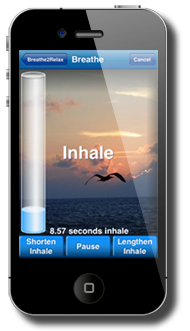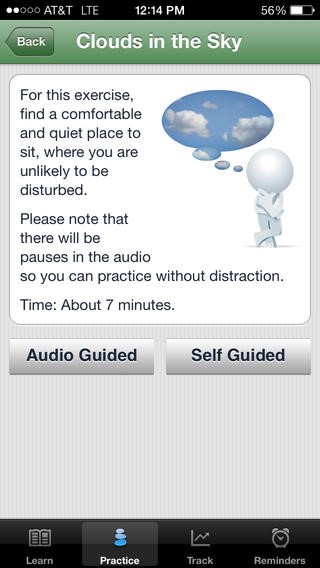Staff Perspective: On Mindfulness
In the past decade, research focused on mindfulness and meditation has increased significantly. Clinical researchers have made substantial progress in efforts to quantify and document the benefits of mindfulness. As a clinician, I will provide a quick clinician’s guide to mindfulness. I will begin with a quick overview of what mindfulness is and isn’t, an introduction of a few applications and finally some resources to consider.
First, mindfulness may be defined as observation without judgment. Think of it as awareness of the here and now. Imagine yourself being present to what is happening in this moment without anticipating the future or being preoccupied with what has already happened. You could be fully aware of the connection you have now to the seat which is holding you up. You may notice that your feet are firmly on the ground or your ankles are crossed or you are holding your cup of coffee as your read this article.
This may seem simple and obvious, but for many of us mindfulness does not happen frequently. We spend much of our time multi-tasking or anticipating consequences. To be mindful is to be aware of thoughts, feelings, and bodily sensations and to accept them without efforts to change or modify what is. For some, this stands in sharp contrast to efforts to relax or de-stress. For example, in mindfulness, you do not make efforts to change your breathing, you simply become much more aware of your breathing and in doing so, you… relax. That is to say, after several minutes of mindful breathing you may experience a decrease in heart rate and blood pressure.
Many people are unclear about the difference between mindfulness and meditation. Although mindfulness can be a meditation, I consider meditation to be a formal practice whereas mindfulness is a state or a skill that may be used to meditate. You may experience mindfulness by bringing your full attention to what is happening in the moment or through a guided exercise such as a body scan. You may also have a formal or informal mindfulness practice. Informally, you may simply bring increased awareness to your everyday activities without creating time in your schedule for a formal practice. Alternatively, you may set aside time each day or each week to engage in a formal guided meditation or engage in some activity with the express intention of being mindful. For example, you may choose to go for a walk on a gravel pathway, bringing your awareness to the experience of walking on an uneven surface. I like to go for long walks truly attending to whatever I may see along the way.
Meditation brings your attention and awareness to something for a particular purpose. Formal meditations may involve Tai Chi, yoga or the martial arts. You may also consider mindful meditations such as focused time watching or following the breath or guided meditations. There are many, many forms of formal meditation, too many to list here. But I assure you, there is a meditation for everyone who chooses to do so. Regardless of which you choose, the benefits are clear.
Research suggests that mindfulness has a number of mental health benefits. First, mindfulness improves emotion regulation, although the mechanisms remain unclear. Second, mindfulness is an excellent form of relaxation. As relaxation is used in a myriad of treatments, having a number of tools can only help your practice. Third, a mindfulness practice may increase your provider resiliency. Given our work with Service members, increasing the resiliency of ourselves and our clients should be a priority. In fact, a new study on the use of mindfulness by Service members suggests that a mindfulness practice increases resiliency in the face of combat. Finally, mindfulness fits with any theoretical orientation.
Mindfulness also has a number of physiological benefits. If you can cultivate a mindfulness practice over a period of time a number of benefits are noted. Mindfulness is believed to reduce levels of the stress hormone, cortisol. Mindfulness helps improve immune function Mindfulness also decreases blood pressure.
Mindfulness apps
T2 has created two mindfulness apps which can be used by individuals in the context of psychotherapy or alone for stress management. Although both apps are user-friendly and very helpful, no app can take the place of psychotherapy with a licensed clinician.
Breathe2Relax (description from T2 website)
Breathe2Relax is an app for stress management focused on diaphragmatic breathing. Breathing exercises have been documented to decrease the body's 'fight-or-flight' (stress) response, and help with mood stabilization, anger control, and anxiety management.
Capitalizing on touch-screen technology, a user can record their stress level on a 'visual analogue scale' by simply swiping a small bar to the left or to the right. Breathe2Relax uses graphics, animation, narration, and videos to deliver a sophisticated, immersive experience for the user
Mindfulness Coach (description from T2 website)
The Mindfulness Coach mobile app was created to introduce the concept of mindfully focusing attention and to facilitate the acquisition of the skill through practice.
Features of Mindfulness Coach include:
- Detailed walkthroughs for nine forms of mindfulness meditation, each including voice-guided sessions with captions and instructions for self-guided sessions
- A session log for tracking mindfulness practice
- Educational materials about the benefits of mindfulness
Wherever you go, there you are: Mindfulness Meditation in Everyday Life
This classic book by Jon Kabat-Zinn, MD is one of the quintessential books on mindfulness in everyday life. This book, first published in 1994, introduced mindfulness to many individuals. Focusing on mindfulness as part of everyday life, formally and informally, Zinn makes mindfulness accessible, not an abstract construct. With chapter tiles like “Practice Does Not Mean Rehearsal,” “You Don’t Have to Go Out of Your Way to Practice,” and “Practice as Path,” he helps people to understand how mindfulness meditation can easily fold into your life.


Breathe2Relax


Questions: Do you use mindfulness personally? Do you use mindfulness in your clinical practice? Please share below how you use mindfulness as part of your daily living.
Dr. Holly O’Reilly is the Lead on Traumatic Stress & Sexual Assault for the Center for Deployment Psychology.
In the past decade, research focused on mindfulness and meditation has increased significantly. Clinical researchers have made substantial progress in efforts to quantify and document the benefits of mindfulness. As a clinician, I will provide a quick clinician’s guide to mindfulness. I will begin with a quick overview of what mindfulness is and isn’t, an introduction of a few applications and finally some resources to consider.
First, mindfulness may be defined as observation without judgment. Think of it as awareness of the here and now. Imagine yourself being present to what is happening in this moment without anticipating the future or being preoccupied with what has already happened. You could be fully aware of the connection you have now to the seat which is holding you up. You may notice that your feet are firmly on the ground or your ankles are crossed or you are holding your cup of coffee as your read this article.
This may seem simple and obvious, but for many of us mindfulness does not happen frequently. We spend much of our time multi-tasking or anticipating consequences. To be mindful is to be aware of thoughts, feelings, and bodily sensations and to accept them without efforts to change or modify what is. For some, this stands in sharp contrast to efforts to relax or de-stress. For example, in mindfulness, you do not make efforts to change your breathing, you simply become much more aware of your breathing and in doing so, you… relax. That is to say, after several minutes of mindful breathing you may experience a decrease in heart rate and blood pressure.
Many people are unclear about the difference between mindfulness and meditation. Although mindfulness can be a meditation, I consider meditation to be a formal practice whereas mindfulness is a state or a skill that may be used to meditate. You may experience mindfulness by bringing your full attention to what is happening in the moment or through a guided exercise such as a body scan. You may also have a formal or informal mindfulness practice. Informally, you may simply bring increased awareness to your everyday activities without creating time in your schedule for a formal practice. Alternatively, you may set aside time each day or each week to engage in a formal guided meditation or engage in some activity with the express intention of being mindful. For example, you may choose to go for a walk on a gravel pathway, bringing your awareness to the experience of walking on an uneven surface. I like to go for long walks truly attending to whatever I may see along the way.
Meditation brings your attention and awareness to something for a particular purpose. Formal meditations may involve Tai Chi, yoga or the martial arts. You may also consider mindful meditations such as focused time watching or following the breath or guided meditations. There are many, many forms of formal meditation, too many to list here. But I assure you, there is a meditation for everyone who chooses to do so. Regardless of which you choose, the benefits are clear.
Research suggests that mindfulness has a number of mental health benefits. First, mindfulness improves emotion regulation, although the mechanisms remain unclear. Second, mindfulness is an excellent form of relaxation. As relaxation is used in a myriad of treatments, having a number of tools can only help your practice. Third, a mindfulness practice may increase your provider resiliency. Given our work with Service members, increasing the resiliency of ourselves and our clients should be a priority. In fact, a new study on the use of mindfulness by Service members suggests that a mindfulness practice increases resiliency in the face of combat. Finally, mindfulness fits with any theoretical orientation.
Mindfulness also has a number of physiological benefits. If you can cultivate a mindfulness practice over a period of time a number of benefits are noted. Mindfulness is believed to reduce levels of the stress hormone, cortisol. Mindfulness helps improve immune function Mindfulness also decreases blood pressure.
Mindfulness apps
T2 has created two mindfulness apps which can be used by individuals in the context of psychotherapy or alone for stress management. Although both apps are user-friendly and very helpful, no app can take the place of psychotherapy with a licensed clinician.
Breathe2Relax (description from T2 website)
Breathe2Relax is an app for stress management focused on diaphragmatic breathing. Breathing exercises have been documented to decrease the body's 'fight-or-flight' (stress) response, and help with mood stabilization, anger control, and anxiety management.
Capitalizing on touch-screen technology, a user can record their stress level on a 'visual analogue scale' by simply swiping a small bar to the left or to the right. Breathe2Relax uses graphics, animation, narration, and videos to deliver a sophisticated, immersive experience for the user
Mindfulness Coach (description from T2 website)
The Mindfulness Coach mobile app was created to introduce the concept of mindfully focusing attention and to facilitate the acquisition of the skill through practice.
Features of Mindfulness Coach include:
- Detailed walkthroughs for nine forms of mindfulness meditation, each including voice-guided sessions with captions and instructions for self-guided sessions
- A session log for tracking mindfulness practice
- Educational materials about the benefits of mindfulness
Wherever you go, there you are: Mindfulness Meditation in Everyday Life
This classic book by Jon Kabat-Zinn, MD is one of the quintessential books on mindfulness in everyday life. This book, first published in 1994, introduced mindfulness to many individuals. Focusing on mindfulness as part of everyday life, formally and informally, Zinn makes mindfulness accessible, not an abstract construct. With chapter tiles like “Practice Does Not Mean Rehearsal,” “You Don’t Have to Go Out of Your Way to Practice,” and “Practice as Path,” he helps people to understand how mindfulness meditation can easily fold into your life.


Breathe2Relax


Questions: Do you use mindfulness personally? Do you use mindfulness in your clinical practice? Please share below how you use mindfulness as part of your daily living.
Dr. Holly O’Reilly is the Lead on Traumatic Stress & Sexual Assault for the Center for Deployment Psychology.

